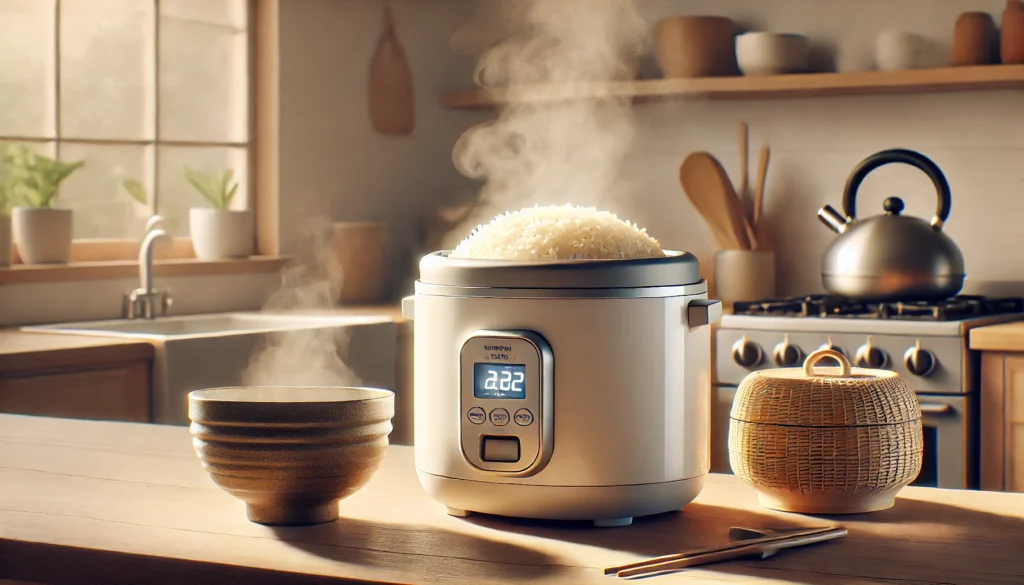Are you looking to master the art of perfectly cooked Japanese rice? Whether you’ve just purchased your first rice cooker or are looking to improve your rice-cooking skills, this comprehensive guide will walk you through everything you need to know about how to use a Japanese rice cooker effectively.
The Cultural Significance of Rice in Japan
In Japan, rice is far more than just a side dish—it’s the foundation of nearly every meal. Similar to how bread is a staple in Western cuisine, rice holds a central role in Japanese food culture. Once you begin cooking and eating Japanese rice regularly, you’ll start to notice subtle flavor differences and textures that make Japanese short-grain rice unique.
Perfect rice complements countless Japanese dishes like miso soup, grilled fish, curry, and traditional favorites like unagi (grilled eel). Learning to cook rice properly is an essential step in mastering Japanese home cooking.
Understanding Your Japanese Rice Cooker
Japanese rice cookers range from simple models with basic functions to high-tech appliances with multiple cooking options. Most modern rice cookers feature:
- A removable inner cooking pot
- A tight-fitting lid
- A heating element
- A control panel with various cooking settings
- Measuring lines inside the pot
- Accessories like a measuring cup and rice paddle
Common Control Panel Features
Most Japanese rice cookers have these standard buttons and functions:
- メニュー (Menu) – Cycles through cooking options
- 炊飯/スタート (Start/Cook) – Begins the cooking process
- 保温 (Keep Warm) – Maintains rice at serving temperature
- 取り消し (Cancel) – Stops operation
- 予約 (Timer) – Sets delayed cooking time
Step-by-Step Guide: How to Use a Japanese Rice Cooker
Step 1: Measure Your Rice
Always use the measuring cup that came with your rice cooker! This cup typically holds about 180ml (approximately 3/4 cup), which is considered one serving of uncooked rice in Japan.
1 rice cooker cup = 1 serving of rice = approximately 180ml
For beginners, start with 2-3 cups for your first attempt.
Step 2: Rinse the Rice Thoroughly
Unless you’re using pre-washed rice (無洗米/musenmai), rinsing is crucial for removing excess starch:
- Place measured rice in a bowl
- Add cold water
- Gently swirl with your hand
- Drain cloudy water
- Repeat 3-4 times until water runs almost clear
This process ensures your rice won’t be sticky or gummy when cooked.
Step 3: Transfer to the Cooking Pot
After rinsing, transfer your rice to the rice cooker’s inner pot.
Step 4: Add the Correct Amount of Water
The perfect rice-to-water ratio is crucial. Most rice cookers have measuring lines inside the pot corresponding to the number of cups used.
If your cooker doesn’t have these lines, follow this traditional method:
- Add water until it reaches just below the first knuckle of your index finger when your fingertip touches the top of the rice
- For 2 cups of white rice, approximately 2.5 cups of water works well
For different types of rice:
- White rice: Follow standard measurement lines
- Brown rice: Add slightly more water
- Mixed rice: Follow recipe specifications
Step 5: Select the Appropriate Cooking Setting
Modern Japanese rice cookers offer multiple cooking modes:
- 白米 (Hakumai) – Standard setting for white rice
- 玄米 (Genmai) – Brown rice setting (longer cooking time)
- 早炊き (Hayazaki) – Quick cooking (shorter time, slightly different texture)
- 炊込み (Takikomi) – For cooking rice with other ingredients
- おかゆ (Okayu) – For rice porridge
- 無洗米 (Musenmai) – For pre-washed rice
Choose the setting that matches your rice type and press the start button (炊飯/スタート).
Step 6: Wait for the Cooking Cycle to Complete
The cooking process typically takes 30-45 minutes for white rice. Your rice cooker will signal when cooking is complete, usually with beeps or a musical tone.
Step 7: Let the Rice Rest
Allow the rice to rest for 10-15 minutes after cooking with the lid closed. Many rice cookers automatically enter a “keep warm” mode after cooking.
Step 8: Fluff and Serve
Open the lid and gently fluff the rice with the provided rice paddle (never use metal utensils that could scratch the cooking pot). Serve your perfectly cooked rice while hot!
Advanced Features Worth Exploring
Timer Function (予約/Yoyaku)
The timer function allows you to set your rice cooker to finish cooking at a specific time:
- Add rice and water as normal
- Press the timer button
- Set the desired completion time (e.g., when you’ll arrive home)
- Press start
This is perfect for having freshly cooked rice ready exactly when you need it.
Keep Warm Function (保温/Hoon)
Most Japanese rice cookers can keep rice warm for hours without drying it out. While convenient, it’s best not to leave rice on this setting for more than 12 hours for food safety and quality reasons.
Mixed Rice Function (炊込み/Takikomi)
This setting allows you to cook rice with other ingredients like vegetables, meat, or seasonings mixed in. Popular examples include:
- Takikomi gohan (rice with vegetables and protein)
- Matsutake gohan (rice with mushrooms)
- Kuri gohan (chestnut rice)
Troubleshooting Common Rice Cooking Problems
Rice Too Hard or Undercooked
- Add slightly more water next time
- Make sure to select the correct rice type
- Allow proper resting time after cooking
Rice Too Soft or Mushy
- Use less water next time
- Make sure you measured properly
- Check that the inner pot is completely dry before adding rice
Rice Sticking to Pot
- Rinse rice more thoroughly
- Make sure the pot is clean before cooking
- Consider a light coating of oil on the pot bottom
Rice Has Burned
- The cooking pot may have been damaged
- Check that the heating element is functioning properly
- Ensure proper water-to-rice ratio
Maintaining Your Japanese Rice Cooker
Proper maintenance ensures your rice cooker’s longevity:
- Unplug the cooker and allow it to cool completely before cleaning
- Remove and wash the inner pot with mild soap
- Wipe the lid and exterior with a damp cloth
- Clean the heating plate if necessary
- Allow all parts to dry completely before reassembling
The inner pot’s non-stick coating requires gentle handling—avoid metal utensils and abrasive cleaners.
Beyond Basic Rice: Expanding Your Rice Cooker Skills
Once you’ve mastered basic rice cooking, you can explore more advanced techniques:
Cooking Different Rice Varieties
- Short-grain (most common in Japan)
- Medium-grain
- Brown rice (requires more water and longer cooking time)
- Mixed grain rice (雑穀米/zakkokumai)
Creative Rice Recipes
- Okayu (rice porridge) for breakfast or when feeling unwell
- Onigiri (rice balls) for lunch boxes
- Ochazuke (rice with green tea) for a light meal
- Tamago kake gohan (rice with raw egg) for a traditional breakfast
Learning Japanese While Cooking
Cooking rice offers a wonderful opportunity to learn some basic Japanese vocabulary. If you’re interested in learning more Japanese while mastering your culinary skills, check out our Hiragana & Katakana Cheat Sheet or JLPT N5 Kanji Cheat Sheet on our resources page.
Understanding the kanji on your rice cooker is a practical way to begin recognizing Japanese characters. For a more comprehensive language foundation, our Counting to 100 in Japanese guide can help you understand measurement quantities.
Sustainability Tips for Rice Cooking
- Save leftover rice for fried rice the next day
- Use rice water from rinsing to water plants
- Consider energy-efficient rice cooker models
- Use locally grown rice when possible
Health Benefits of Properly Cooked Rice
Properly cooked Japanese rice offers numerous health benefits:
- Easy to digest
- Low in fat
- Naturally gluten-free
- Provides sustainable energy
- Contains essential amino acids
If you’re watching your carbohydrate intake, consider mixing white rice with brown rice or using the multi-grain setting on your rice cooker.
Seasonal Rice Cooking Tips
Summer
- Store cooked rice in smaller portions to prevent spoilage
- Consider cooking in the evening to avoid heating your kitchen
Winter
- The “keep warm” function can help maintain a comfortable serving temperature longer
- Warm rice dishes like zosui (rice soup) are perfect for cold evenings
Conclusion: Mastering Your Japanese Rice Cooker
Learning how to use a Japanese rice cooker properly is an investment that pays delicious dividends for years to come. With practice, you’ll develop an intuitive understanding of rice-to-water ratios and cooking times that suit your taste preferences.
Remember that perfect rice begins with quality ingredients, proper measuring, and paying attention to the details. Your Japanese rice cooker is designed to handle the technical aspects of cooking, but your preparation makes all the difference.
For more tips on Japanese cooking and language learning, explore our 100+ Essential Japanese Phrases guide to help you navigate Japanese recipes and cooking instructions with confidence.
Have you mastered using your Japanese rice cooker? What’s your favorite dish to serve with freshly cooked Japanese rice? We’d love to hear about your experiences in the comments below!




